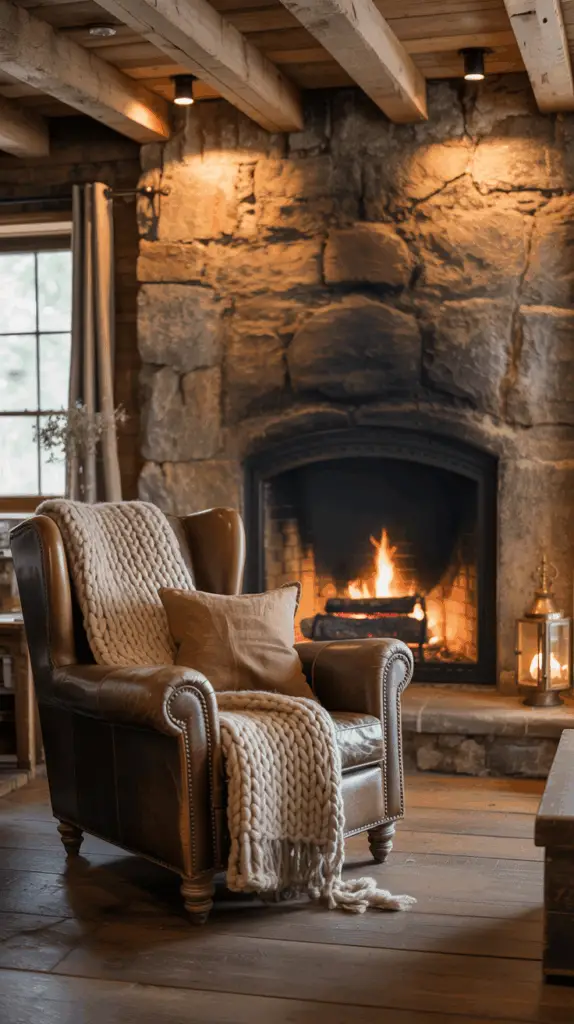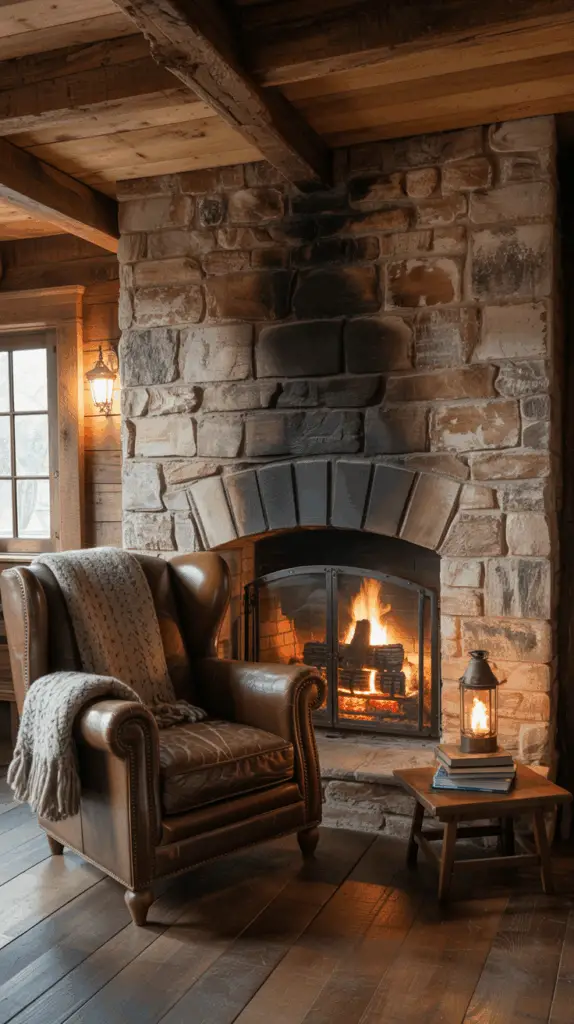Discover the Beauty of Warm Rustic Living Room Designs: How to Create a Cozy, Inviting Space
Table of Contents
Introduction
There’s something undeniably inviting about a warm, rustic living room. The blend of natural materials, cozy textiles, and earthy tones creates an atmosphere that feels both timeless and comforting. Imagine settling into a plush sofa surrounded by wooden beams, stone accents, and soft lighting that enhances the room’s warmth. Rustic living rooms have become a staple in modern home design, offering a retreat where style and comfort go hand in hand.
The charm of rustic living room designs lies in their ability to evoke a sense of calm and authenticity. Whether you’re drawn to the farmhouse appeal of reclaimed wood and vintage furnishings or the natural beauty of stone fireplaces and earth-toned textiles, warm rustic designs make you feel right at home. This style celebrates the natural world, often incorporating elements that tell a story of craftsmanship, tradition, and sustainability. But creating a rustic living room isn’t just about decorating with vintage pieces—it’s about weaving a narrative of comfort, simplicity, and beauty.
In this post, we’ll dive into the key components of warm rustic living room designs, from furniture and color palettes to materials and accessories. You’ll learn how to design a space that’s both aesthetically pleasing and functional, perfect for relaxing with family or entertaining guests. Whether you live in a country farmhouse or a city apartment, these tips will help you bring rustic warmth into your living room.
Choosing the Right Color Palette for a Rustic Living Room
Color plays a central role in creating the warm, inviting atmosphere of a rustic living room. A successful rustic design relies heavily on natural, earthy tones that evoke the charm of the countryside. Rich browns, deep greens, muted golds, and soft grays are often used as base colors, providing a grounded and cozy feel. These hues work well with the natural textures of wood, stone, and leather, creating a cohesive look that feels both calming and sophisticated.
To complement the earthy tones, you can introduce pops of accent colors like burnt orange, mustard yellow, or even a muted red. These colors can be added through accessories such as throw pillows, rugs, and artwork, creating warmth and depth without overwhelming the space. For a more minimalist approach, you can stick to a neutral palette of whites, grays, and beiges, which will allow the natural materials in the room to take center stage.
It’s important to balance dark tones with lighter shades to prevent the room from feeling too heavy. For example, if you’re using a lot of dark wood furniture, balance it with light-colored walls or soft fabrics to keep the space feeling airy and fresh.
Table: Popular Color Palettes for Rustic Living Rooms
| Color Palette | Best For | Vibe |
| Earthy Browns, Grays, and Greens | Traditional, farmhouse-style rooms | Warm, natural, cozy |
| Beige, White, Light Grays | Modern rustic spaces | Clean, minimalist, serene |
| Burnt Orange, Mustard, Olive Green | Vintage or eclectic rustic spaces | Bold, vibrant, and welcoming |
| Deep Charcoal, Taupe, Cream | Urban rustic rooms | Sophisticated, grounded, contemporary |
Incorporating Natural Materials in Rustic Design
One of the hallmarks of rustic living room designs is the use of natural materials. These materials bring an earthy, organic feel to the space and create a connection to the outdoors. Wood, stone, leather, and wool are some of the most popular choices for rustic décor.
- Wood: Reclaimed wood is a quintessential feature in rustic design. Whether it’s used for beams, flooring, furniture, or accent walls, the natural grain and texture of wood create a timeless, rustic look. Dark mahogany or oak wood can be used for furniture, while lighter pine or cedar can brighten up the room.
- Stone: A stone fireplace is often the centerpiece of a rustic living room. The rough texture of stone contrasts beautifully with the softness of upholstered furniture, creating visual interest. Stone can also be used for accent walls or flooring, further enhancing the natural, earthy vibe of the room.
- Leather: Leather furniture adds a touch of luxury and durability to rustic living rooms. A deep leather sofa or armchair complements wooden furniture and adds a sense of timeless sophistication to the space. Opt for soft, weathered leather for a more authentic, lived-in look.
- Wool and Linen: For soft furnishings like throw blankets, pillows, and curtains, wool and linen are perfect choices. These natural fabrics add texture, warmth, and comfort to the room, enhancing the overall rustic feel.
By incorporating these natural materials, you’ll create a living room that feels grounded, authentic, and full of character.
Table: Natural Materials to Use in Rustic Living Rooms
| Material | Best Uses | Effect |
| Wood | Furniture, beams, flooring, accent walls | Adds warmth, texture, and timeless appeal |
| Stone | Fireplaces, accent walls, flooring | Creates a natural, earthy focal point |
| Leather | Sofas, armchairs, ottomans | Durable, luxurious, and adds sophistication |
| Wool & Linen | Throw blankets, pillows, curtains | Soft, natural textures that add comfort |

Furniture Choices for a Warm Rustic Living Room
Furniture is key to creating the perfect warm rustic living room. The pieces you choose should reflect the natural, cozy aesthetic of the room while providing comfort and functionality. Here are some furniture ideas to help bring your rustic design to life:
- Wooden Coffee Tables: A large wooden coffee table made from reclaimed wood or a tree stump adds authenticity to the room. Choose a table with a simple design to keep the focus on the material rather than excessive ornamentation.
- Leather Sofas and Chairs: A leather sofa or armchair brings sophistication and durability to the space. Opt for rich, warm tones like deep brown, saddle, or tan for a classic look.
- Antique or Vintage Pieces: Adding vintage or antique furniture can enhance the rustic feel of the room. Look for pieces like wooden bookshelves, distressed cabinets, or wicker baskets to store blankets or magazines.
- Oversized Rugs: A large area rug made from wool, jute, or cotton can help anchor the space and create a cozy atmosphere. Go for neutral tones or traditional patterns, like plaids or kilim rugs, to complement the rustic design.
When selecting furniture, consider combining different textures and finishes. A mix of rough-hewn wooden pieces with soft, luxurious fabrics like linen or velvet creates an interesting contrast and adds depth to the design.
Table: Furniture Choices for a Rustic Living Room
| Furniture Piece | Material | Effect |
| Wooden Coffee Table | Reclaimed wood | Adds rustic charm and serves as a focal point |
| Leather Sofa | Leather | Luxurious, durable, and enhances the rustic aesthetic |
| Vintage Accent Chairs | Wood, fabric | Adds character and nostalgia to the space |
| Oversized Rugs | Wool, jute, cotton | Grounds the space, adds warmth and comfort |

Lighting Ideas for a Rustic Living Room
Lighting is an essential element in any room, but it’s especially important in a rustic living room. The right lighting can enhance the natural materials in the room, create a warm ambiance, and highlight the architectural features that define rustic design. Here are some lighting ideas to bring your rustic living room to life:
- Warm Ambient Lighting: Choose soft, warm lights to create a cozy atmosphere. Pendant lights with metal or wooden finishes can complement the rustic aesthetic. Recessed lighting or dimmable floor lamps allow you to adjust the light levels for different moods.
- Statement Chandeliers: A wrought iron or antler chandelier can serve as a striking focal point in a rustic living room. Choose a design that complements the overall color palette and materials, like a dark bronze chandelier for a vintage look or a wooden fixture for a more natural feel.
- Task Lighting: Table lamps with wooden bases or industrial-style floor lamps provide functional lighting for reading or other activities. Select lamps with soft, textured shades to keep the atmosphere warm and inviting.
- Accent Lighting: Use accent lighting to highlight key features in the room, like artwork, a fireplace, or rustic furniture. Wall sconces or LED strips placed under shelves or behind furniture can create an atmospheric glow and add drama to the space.
Lighting in a rustic living room should be layered to ensure the room is both functional and aesthetically pleasing.
Table: Lighting Options for Rustic Living Rooms
| Lighting Type | Best For | Effect |
| Ambient Lighting | General room illumination | Soft, warm glow, sets the cozy tone |
| Statement Chandeliers | Room centerpiece | Dramatic, focal point, enhances rustic charm |
| Task Lighting | Reading, activities near the seating area | Functional, adjustable, creates a cozy atmosphere |
| Accent Lighting | Highlighting artwork, furniture, or décor | Adds depth, creates visual interest |
Conclusion
A warm rustic living room design is the perfect blend of comfort, style, and natural beauty. By embracing earthy tones, incorporating natural materials, and selecting the right furniture and lighting, you can create a space that feels like a retreat from the everyday hustle. Whether you opt for a traditional farmhouse look or a more contemporary rustic vibe, the key is to focus on warmth, coziness, and authenticity. With the right elements, your living room can become the heart of your home—a space where friends and family gather to relax, unwind, and enjoy the beauty of rustic design.

